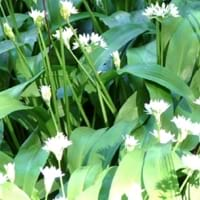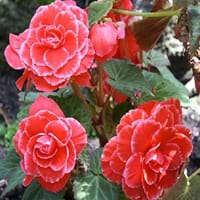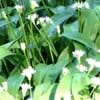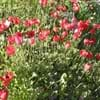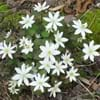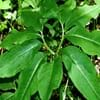Life Span
Annual
Perennial
Type
Bulb or Corm or Tuber
Bulb or Corm or Tuber
Origin
World/Pandemic, North America, Europe, Northern Europe, Russia/Siberia, Northern Africa, Asia, India
Hybrid origin
Types
Silverskin garlic, Artichoke garlic
'Bellagio Apricot' begonia, 'Bellagio Blush' begonia, 'Bellagio Pink' begonia
Habitat
Fields, Loamy soils
Subtropical climates, Tropical regions
USDA Hardiness Zone
4-9
9-15
Habit
Clump-Forming
Clump-Forming
Flower Color Modifier
Bicolor
Bicolor
Fruit Color
Yellow green
Not Available
Leaf Color in Spring
Light Green
Green
Leaf Color in Summer
Light Green
Light Green
Leaf Color in Fall
Several shades of Green
Several shades of Green
Leaf Color in Winter
Light Green
Light Green
Leaf Shape
Long Narrow
Heart-shaped
Plant Season
Summer
Summer, Fall
Sunlight
Full Sun, Partial Sun
Partial shade
Growth Rate
Medium
Medium
Type of Soil
Loam, Sand
Loam, Sand
The pH of Soil
Neutral
Acidic, Neutral
Soil Drainage
Well drained
Well drained
Bloom Time
Spring, Late Spring, Early Summer, Summer, Late Summer, Early Fall
Early Summer, Summer, Late Summer
Tolerances
Drought
Not Available
Where to Plant?
Container, Ground
Container, Ground, Pot
How to Plant?
Seedlings
Seedlings, Transplanting
Plant Maintenance
Medium
Medium
Watering Requirements
Keep ground moist, Never Over-water
Over-watering can cause leaf problems or root diseases, Requires regular watering, Water Deeply
In Summer
Lots of watering
Lots of watering
In Spring
Moderate
Moderate
In Winter
Average Water
Average Water
Soil pH
Neutral
Acidic, Neutral
Soil Type
Loam, Sand
Loam, Sand
Soil Drainage Capacity
Well drained
Well drained
Sun Exposure
Full Sun, Partial Sun
Partial shade
Pruning
No pruning needed, Remove damaged leaves, Remove dead branches, Remove dead leaves
Cut or pinch the stems, No pruning needed in the early stages, Prune if you want to improve plant shape, Prune to control growth, Remove dead or diseased plant parts
Fertilizers
fertilize in fall, Nitrogen
All-Purpose Liquid Fertilizer
Pests and Diseases
Bacterial leaf spot, Nematodes, Purple Blotch, Red blotch, Seedcorn maggot
Aphids, Bacterial leaf spot, Botrytis Blight, Foliar nematode, Powdery mildew, Pythium rot, Rhizoctonia crown rot
Plant Tolerance
Dry soil, Shade areas
Drought
Flower Petal Number
Single
Double
Fragrant Flower
Not Available
No
Fragrant Fruit
Not Available
No
Fragrant Leaf
Not Available
No
Fragrant Bark/Stem
Yes
No
Foliage Texture
Medium
Coarse
Foliage Sheen
Matte
Glossy
Attracts
Bugs, Flying insects, Insects
Not Available
Allergy
Dermatitis, Pain and fatigue
Asthma
Aesthetic Uses
Not Used For Aesthetic Purpose
Beautification
Beauty Benefits
Acne, For treating wrinkles, Making cosmetics, Removes pimples
Not Available
Environmental Uses
Indoor Air Purification, Insect Repellent
Air purification
Medicinal Uses
Acne, Aging, anti-allergy, Antidepressant, Antiseptic, epilepsy, Nerve pain, Obesity, Vomiting
Bronchitis, Candidiasis, Cold, Digestive disorders, Dysentry, Haemoptysis, Liver problems, Menstrual Disorders, Scrofula, Swelling
Part of Plant Used
Bulbs
Whole plant
Other Uses
Can be made into a herbal tea, Medicinal oil, Oil is used in mosquito repellents, Use in Chinese herbology, Used for its medicinal properties
Used as Ornamental plant
Used As Indoor Plant
No
Yes
Used As Outdoor Plant
Yes
Yes
Garden Design
Not Available
Bedding Plant, Container, Hanging Basket, Houseplant, Tropical
Botanical Name
ALLIUM vineale
BEGONIA 'Fortune Salmon'
Common Name
Wild Garlic
Fortune Salmon Tuberous Begonia, Tuberous Begonia
In Hindi
लहसुन
tuberous बिगोनिया
In German
Knoblauch
Knollenbegonie
In French
Ail
Bégonia tubéreux
In Spanish
Ajo
Begonia tuberosa
In Greek
σκόρδο
Οζώδους Begonia
In Portuguese
alho
tuberosa Begonia
In Polish
czosnek
Begonia guzowate
In Latin
allium
Morbus Begonia
Phylum
Magnoliophyta
Magnoliophyta
Class
Liliopsida
Magnoliopsida
Order
Liliales
Cucurbitales
Family
Liliaceae
Begoniaceae
Clade
Monocotyledonous
Angiosperms, Eudicots, Rosids
Tribe
Not Available
Not Available
Subfamily
Lilioideae
Not Available
Importance of Wild Garlic and Tuberous Begonia
Want to have the most appropriate plant for your garden? You might want to know the importance of Wild Garlic and Tuberous Begonia. Basically, these two plants vary in many aspects. Compare Wild Garlic and Tuberous Begonia as they differ in many characteristics such as their life, care, benefits, facts, etc. Every gardener must at least have the slightest clue about the plants he wants to plant in his garden. Compare their benefits, which differ in many ways like facts and uses. The medicinal use of Wild Garlic is Acne, Aging, anti-allergy, Antidepressant, Antiseptic, epilepsy, Nerve pain, Obesity and Vomiting whereas of Tuberous Begonia is Bronchitis, Candidiasis, Cold, Digestive disorders, Dysentry, Haemoptysis, Liver problems, Menstrual Disorders, Scrofula and Swelling. Wild Garlic has beauty benefits as follows: Acne, For treating wrinkles, Making cosmetics and Removes pimples while Tuberous Begonia has beauty benefits as follows: Acne, For treating wrinkles, Making cosmetics and Removes pimples.
Compare Facts of Wild Garlic vs Tuberous Begonia
How to choose the best garden plant for your garden depending upon its facts? Here garden plant comparison will help you to solve this query. Compare the facts of Wild Garlic vs Tuberous Begonia and know which one to choose. As garden plants have benefits and other uses, allergy is also a major drawback of plants for some people. Allergic reactions of Wild Garlic are Dermatitis and Pain and fatigue whereas of Tuberous Begonia have Asthma respectively. Having a fruit bearing plant in your garden can be a plus point of your garden. Wild Garlic has no showy fruits and Tuberous Begonia has no showy fruits. Also Wild Garlic is not flowering and Tuberous Begonia is not flowering . You can compare Wild Garlic and Tuberous Begonia facts and facts of other plants too.
